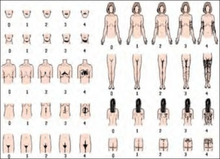Ferriman–Gallwey score
The Ferriman–Gallwey score is a method of evaluating and quantifying hirsutism in women. The method was originally published in 1961 by D. Ferriman and J.D. Gallwey in the Journal of Clinical Endocrinology.[1]

The original method used 11 body areas to assess hair growth, but was decreased to 9 body areas in the modified method:
- Upper lip
- Chin
- Chest
- Upper back
- Lower back
- Upper abdomen
- Lower abdomen
- Upper arms
- Forearms (deleted in the modified method)
- Thighs
- Legs (deleted in the modified method)
In the modified method, hair growth is rated from 0 (no growth of terminal hair) to 4 (extensive hair growth) in each of the nine locations. A patient's score may therefore range from a minimum score of 0 to a maximum score of 36. With each ethnic group, the amount of hair expected for that ethnicity should be considered. For example, in Caucasian women, a score of 8 or higher is regarded as indicative of androgen excess.
The method was further modified in 2001 to include a total of 19 locations, with the 10 extra locations being: sideburns, neck, buttocks, inguinal area, perianal area, forearm, leg, foot, toes and fingers. Each area has its own specified definition of the four-point scale.[2]
References
- Ferriman D, Gallwey JD: Clinical assessment of body hair growth in women. Journal of Clinical Endocrinology 1961; 21:1440–1447.
- Goodman N, Bledsoe M, Cobin R, Futterweit W, Goldzieher J, Petak S, Smith K, Steinberger E: "American Association of Clinical Endocrinologists Hyperandrogenism Guidelines". Endocrine Practice 2001; 7(2):120–134
External links
- "Ferriman Gallwey Evaluation of Hirsutism" – Hirsutism.com (accessed 2011-02-17)